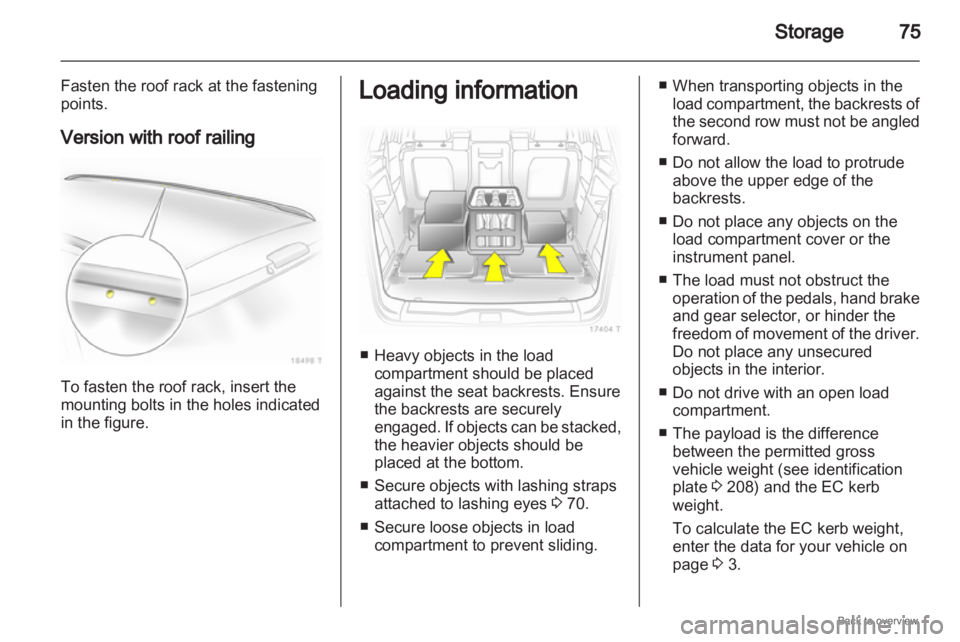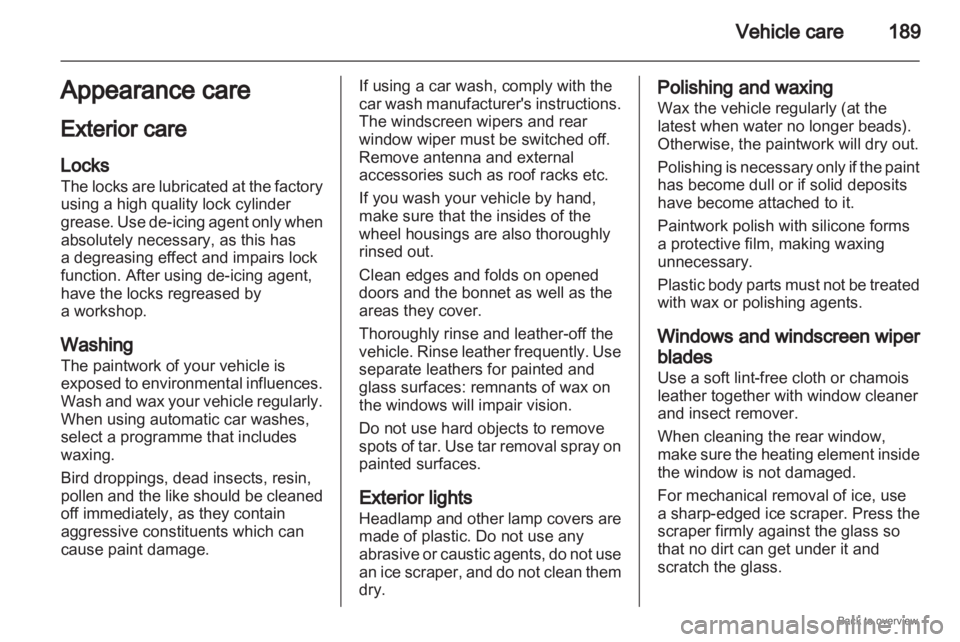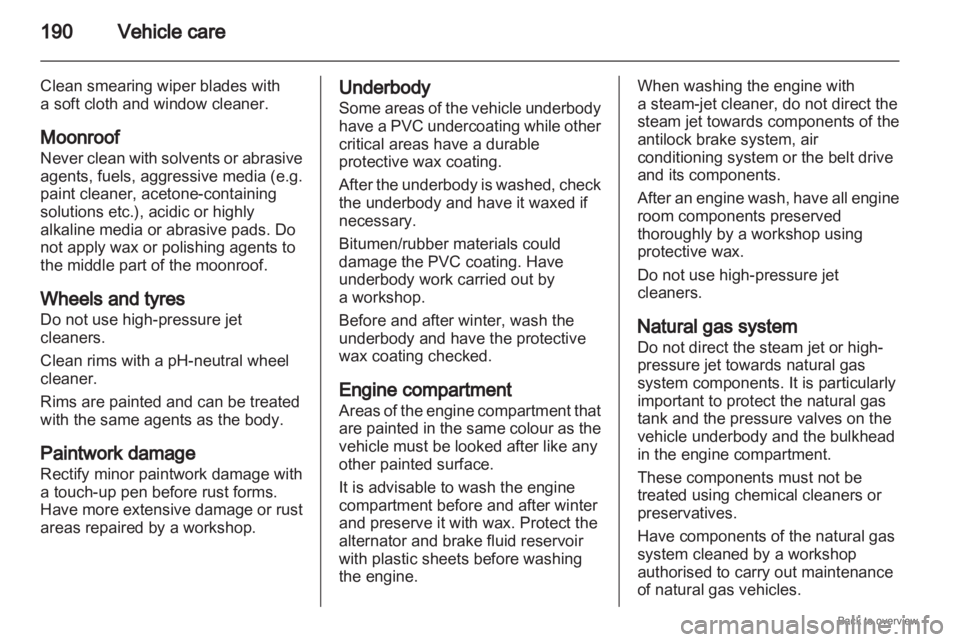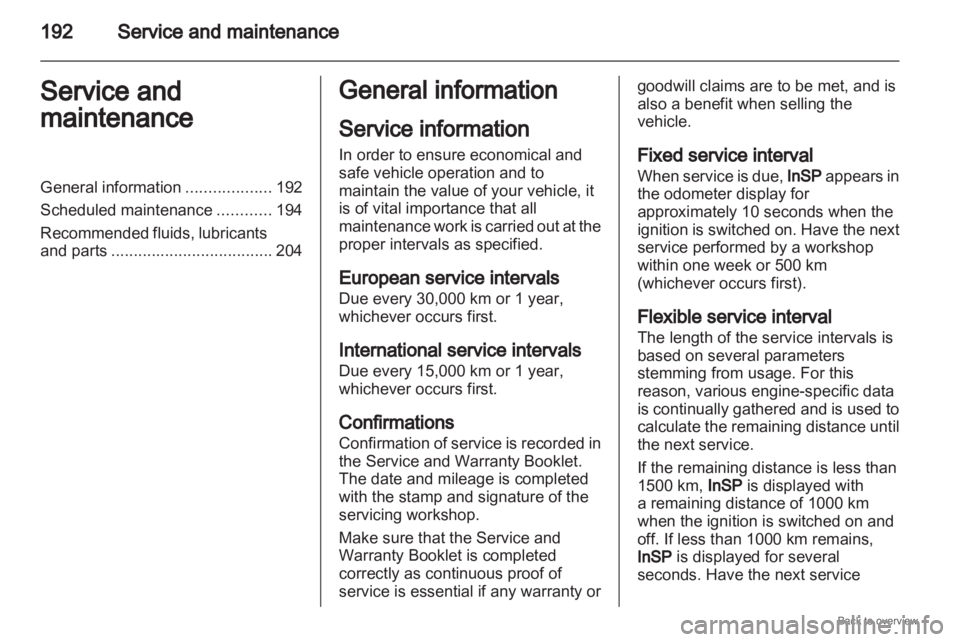Page 75 of 228

Storage
75
Fasten the roof rack at the fastening
points.
Version with roof railing To fasten the roof rack, insert the
mounting bolts in the holes indicated
in the figure. Loading information
■ Heavy objects in the load
compartment should be placed
against the seat backrests. Ensure
the backrests are securely
engaged.
If objects can be stacked,
the heavier objects should be
placed at the bottom.
■ Secure objects with lashing straps attached to lashing eyes 3 70.
■ Secure loose objects in load compartment to prevent sliding. ■ When transporting objects in the
load
compartment, the backrests of
the second row must not be angled
forward.
■ Do not allow the load to protrude above the upper edge of the
backrests.
■ Do not place any objects on the load compartment cover or the
instrument panel.
■ The load must not obstruct the operation of the pedals, hand brake
and gear selector, or hinder the
freedom of movement of the driver.
Do not place any unsecured
objects in the interior.
■ Do not drive with an open load compartment.
■ The payload is the difference between the permitted gross
vehicle weight (see identification
plate 3 208) and the EC kerb
weight.
To calculate the EC kerb weight,
enter the data for your vehicle on
page 3 3.
Page 76 of 228
76
Storage
The EC kerb weight includes
weights for the driver (68 kg),
luggage (7 kg) and all fluids (tank
90% full).
Optional equipment and
accessories increase the kerb
weight.
■
Driving with a roof load increases the sensitivity of the vehicle to
cross-winds and has a detrimental
effect on vehicle handling due to
the vehicle’s higher centre of
gravity. Distribute the load evenly
and secure it properly with retaining
straps. Adjust the tyre pressure and
vehicle speed according to the load
conditions. Check and retighten the
straps frequently.
The permissible roof load is 75 kg
and 100 kg for vehicles with roof
railing. The roof load is the
combined weight of the roof rack
and the load.
Page 189 of 228

Vehicle care
189
Appearance care
Exterior care
Locks
The
locks are lubricated at the factory
using a high quality lock cylinder
grease. Use de-icing agent only when
absolutely necessary, as this has
a degreasing effect and impairs lock
function. After using de-icing agent,
have the locks regreased by
a workshop.
Washing
The paintwork of your vehicle is
exposed to environmental influences.
Wash and wax your vehicle regularly.
When using automatic car washes,
select a programme that includes
waxing.
Bird droppings, dead insects, resin,
pollen and the like should be cleaned
off immediately, as they contain
aggressive constituents which can
cause paint damage. If using a car wash, comply with the
car
wash manufacturer's instructions.
The windscreen wipers and rear
window wiper must be switched off.
Remove antenna and external
accessories such as roof racks etc.
If you wash your vehicle by hand,
make sure that the insides of the
wheel housings are also thoroughly
rinsed out.
Clean edges and folds on opened
doors and the bonnet as well as the
areas they cover.
Thoroughly rinse and leather-off the
vehicle. Rinse leather frequently. Use
separate leathers for painted and
glass surfaces: remnants of wax on
the windows will impair vision.
Do not use hard objects to remove
spots of tar. Use tar removal spray on
painted surfaces.
Exterior lights
Headlamp and other lamp covers are
made of plastic. Do not use any
abrasive or caustic agents, do not use
an ice scraper, and do not clean them
dry. Polishing and waxing
Wax the vehicle regularly (at the
latest when water no longer beads).
Otherwise, the paintwork will dry out.
Polishing
is necessary only if the paint
has become dull or if solid deposits
have become attached to it.
Paintwork polish with silicone forms
a protective film, making waxing
unnecessary.
Plastic body parts must not be treated
with wax or polishing agents.
Windows and windscreen wiper
blades
Use a soft lint-free cloth or chamois
leather together with window cleaner
and insect remover.
When cleaning the rear window,
make sure the heating element inside
the window is not damaged.
For mechanical removal of ice, use
a sharp-edged ice scraper. Press the
scraper firmly against the glass so
that no dirt can get under it and
scratch the glass.
Page 190 of 228

190
Vehicle care
Clean smearing wiper blades with
a soft cloth and window cleaner.
Moonroof
Never
clean with solvents or abrasive
agents, fuels, aggressive media (e.g.
paint cleaner, acetone-containing
solutions etc.), acidic or highly
alkaline media or abrasive pads. Do
not apply wax or polishing agents to
the middle part of the moonroof.
Wheels and tyres
Do not use high-pressure jet
cleaners.
Clean rims with a pH-neutral wheel
cleaner.
Rims are painted and can be treated
with the same agents as the body.
Paintwork damage
Rectify minor paintwork damage with
a touch-up pen before rust forms.
Have more extensive damage or rust
areas repaired by a workshop. Underbody
Some
areas of the vehicle underbody
have a PVC undercoating while other
critical areas have a durable
protective wax coating.
After the underbody is washed, check
the underbody and have it waxed if
necessary.
Bitumen/rubber materials could
damage the PVC coating. Have
underbody work carried out by
a workshop.
Before and after winter, wash the
underbody and have the protective
wax coating checked.
Engine compartment
Areas of the engine compartment that
are painted in the same colour as the
vehicle must be looked after like any
other painted surface.
It is advisable to wash the engine
compartment before and after winter
and preserve it with wax. Protect the
alternator and brake fluid reservoir
with plastic sheets before washing
the engine. When washing the engine with
a steam-jet cleaner, do not direct the
steam jet towards components of the
antilock brake system, air
conditioning system or the belt drive
and its components.
After
an engine wash, have all engine
room components preserved
thoroughly by a workshop using
protective wax.
Do not use high-pressure jet
cleaners.
Natural gas system
Do not direct the steam jet or high-
pressure jet towards natural gas
system components. It is particularly
important to protect the natural gas
tank and the pressure valves on the
vehicle underbody and the bulkhead
in the engine compartment.
These components must not be
treated using chemical cleaners or
preservatives.
Have components of the natural gas
system cleaned by a workshop
authorised to carry out maintenance
of natural gas vehicles.
Page 192 of 228

192
Service and maintenance
Service and
maintenance
General information ...................192
Scheduled maintenance ............194
Recommended
fluids, lubricants
and parts .................................... 204 General information
Service information
In order to ensure economical and
safe vehicle operation and to
maintain the value of your vehicle, it
is of vital importance that all
maintenance
work is carried out at the
proper intervals as specified.
European service intervals
Due every 30,000 km or 1 year,
whichever occurs first.
International service intervals
Due every 15,000 km or 1 year,
whichever occurs first.
Confirmations
Confirmation of service is recorded in
the Service and Warranty Booklet.
The date and mileage is completed
with the stamp and signature of the
servicing workshop.
Make sure that the Service and
Warranty Booklet is completed
correctly as continuous proof of
service is essential if any warranty or goodwill claims are to be met, and is
also a benefit when selling the
vehicle.
Fixed service interval
When
service is due, InSP appears in
the odometer display for
approximately 10 seconds when the
ignition is switched on. Have the next
service performed by a workshop
within one week or 500 km
(whichever occurs first).
Flexible service interval
The length of the service intervals is
based on several parameters
stemming from usage. For this
reason, various engine-specific data
is continually gathered and is used to
calculate the remaining distance until
the next service.
If the remaining distance is less than
1500 km, InSP is displayed with
a remaining distance of 1000 km
when the ignition is switched on and
off. If less than 1000 km remains,
InSP is displayed for several
seconds. Have the next service
Page 217 of 228
Technical data
217
Additional weight
Engine Z16XEP Z16XER Z16XE1 Z16YNG Z18XER Z20LER Z20LEH
Edition/Enjoy [kg] 10 10 10 10 10 5 –
Cosmo [kg] 23 23 23 23 23 16 –
Sport [kg] 20 20 20 – 20 13 –
Engine Z22YH A17DTJ A17DTR Z19DTL Z19DT Z19DTH
Edition/Enjoy [kg] 5 5 5 5 5 5
Cosmo [kg] 16 16 16 16 16 16
Sport [kg] 13 13 13 13 13 13
Heavy accessories
Accessories
Moon roof Towing equipment Headlamp washer system Adaptive forward lighting
Weight [kg] 35 17 3 4
Page 218 of 228
218
Technical data
Vehicle dimensions Zafira Zafira OPC
Length [mm] 4467 4503
Width without exterior mirrors [mm] 1801 1801
Width with two exterior mirrors [mm] 2025 2025
Height (without antenna) [mm] 1635 1635
Height with panorama roof (without antenna) [mm] 1670 1670
Length of load compartment floor [mm] 1088 1088
Load compartment width [mm] 1071 1071
Height of load compartment opening [mm] 895 895
Wheelbase [mm] 2703 2703
Turning circle diameter [m] 11.50 11.85
Page 222 of 228
222
Technical data
Comfort with up to 3 people ECO with up to 3 people With full load
Engine Tyres front
rearfrontrearfrontrear
[kPa/bar] [kPa/bar] [kPa/bar] [kPa/bar] [kPa/bar] [kPa/bar]
A17DTJ, A17DTR 195/60 R 16 260/2.6 240/2.4 – – 280/2.8 320/3.2
195/65 R 15
6)
, 240/2.4 220/2.2 –
–260/2.6 310/3.1
205/55 R 16,
225/45 R 17 225/40 R 18 250/2.5 230/2.3 – – 270/2.7 310/3.1
Z19DTL,
Z19DT,
Z19DTH 195/60 R16 260/2.6 240/2.4 – – 280/2.8 320/3.2
205/55 R 16,
240/2.4 220/2.2 – –260/2.6 310/3.1
225/45 R 17 205/55 R 16
7)
, 250/2.5 230/2.3 –
–260/2.6 310/3.1
225/45 R 17 4) 225/40 R 18
8) 250/2.5 230/2.3 – – 270/2.7 310/3.1
all Temporary spare wheel 420/4.2 420/4.2 – – 420/4.2 420/4.2
6)
Only with A17DTJ.
7) Z19DTH with automatic transmission and moon roof.
4) For a correct speed display reprogramme the speedometer.
8) Not for Z19DTL.